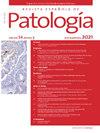External quality assessment for EGFR exon 20 mutation testing in patients with non-small cell lung cancer in Spain
IF 0.5
Q4 Medicine
引用次数: 0
Abstract
Introduction and aim
Non-small cell lung cancer (NSCLC) can arise from insertions in exon 20 of the EGFR gene, among other alterations. We carried out an external quality assessment (EQA) to evaluate the accuracy of laboratory methods and to highlight the importance of detecting and identifying genetic alterations, such as EGFR exon 20 insertion, in patients with NSCLC.
Materials and methods
The 2021 EGRF exon 20 EQA program consisted of two rounds, in which four formalin-fixed paraffin-embedded specimens (round 1: two positive for EGFR exon 20 insertions/duplications, one positive for a common EGFR alteration, and one wild-type; round 2: three positive for EGFR exon 20 insertions/duplications and one wild-type) obtained from patients with NSCLC were tested.
Results
Approximately 80% of the invited laboratories participated in each round. The most common DNA isolation techniques used were the cobas® DNA Sample Preparation Kit (46.7%) in round 1 and QIAamp (37.1%) in round 2. The most frequently used genotyping method in both rounds was the cobas® EGFR Mutation Test (round 1: 53.3%; round 2: 37.1%). In both rounds, 71.1% and 73.6% of the tests, respectively, reported the expected result. The lowest success rate was observed in the H773delinsRY Exon 20 determination (round 1: 17.8%; round 2: 31.4%). This alteration was correctly determined only by next-generation sequencing.
Conclusions
The variability in the genotyping methods and the success rate obtained in our study highlight the importance of EQA in Spain to ensure high performance.
西班牙非小细胞肺癌患者EGFR外显子20突变检测的外部质量评估
非小细胞肺癌(NSCLC)可由EGFR基因外显子20的插入和其他改变引起。我们进行了一项外部质量评估(EQA)来评估实验室方法的准确性,并强调检测和识别遗传改变的重要性,如EGFR外显子20插入,在NSCLC患者中。材料和方法2021年EGRF外显子20 EQA项目由两轮组成,其中四个福尔马林固定石蜡包埋标本(第一轮:两个为EGFR外显子20插入/重复阳性,一个为普通EGFR改变阳性,一个为野生型;第2轮:检测了从NSCLC患者中获得的3个EGFR外显子20阳性插入/重复和1个野生型。结果每轮约有80%的受邀实验室参与。最常用的DNA分离技术是cobas®DNA样品制备试剂盒(46.7%)和QIAamp(37.1%)。两轮中最常用的基因分型方法是cobas®EGFR突变试验(第1轮:53.3%;第二轮:37.1%)。在这两轮测试中,分别有71.1%和73.6%的测试报告了预期结果。H773delinsRY外显子20检测的成功率最低(第1轮:17.8%;第二轮:31.4%)。这种改变只有通过下一代测序才能正确确定。结论本研究中基因分型方法和成功率的差异突出了EQA在西班牙确保高效的重要性。
本文章由计算机程序翻译,如有差异,请以英文原文为准。
求助全文
约1分钟内获得全文
求助全文
来源期刊

Revista Espanola de Patologia
Medicine-Pathology and Forensic Medicine
CiteScore
0.90
自引率
0.00%
发文量
53
审稿时长
34 days
 求助内容:
求助内容: 应助结果提醒方式:
应助结果提醒方式:


